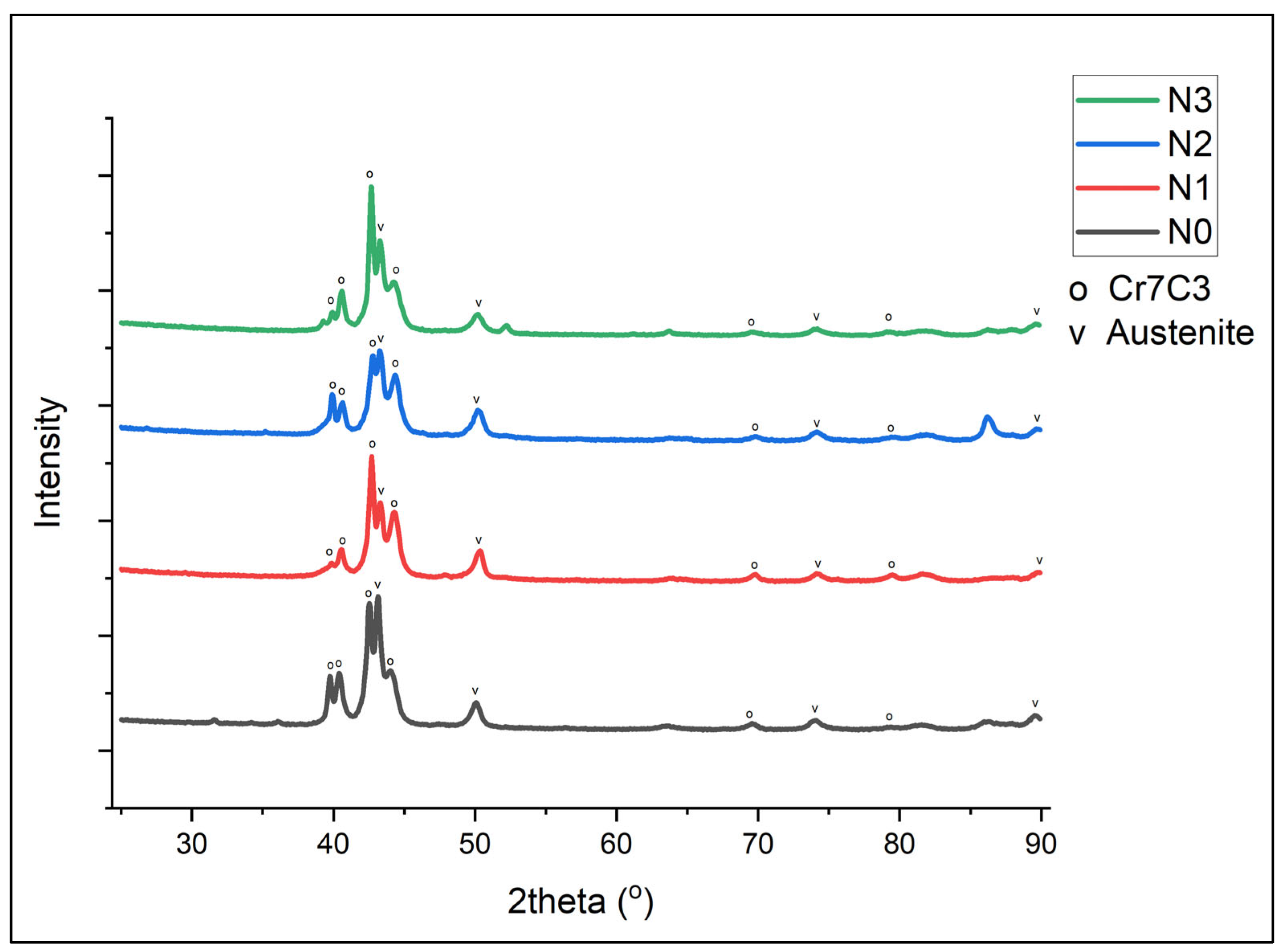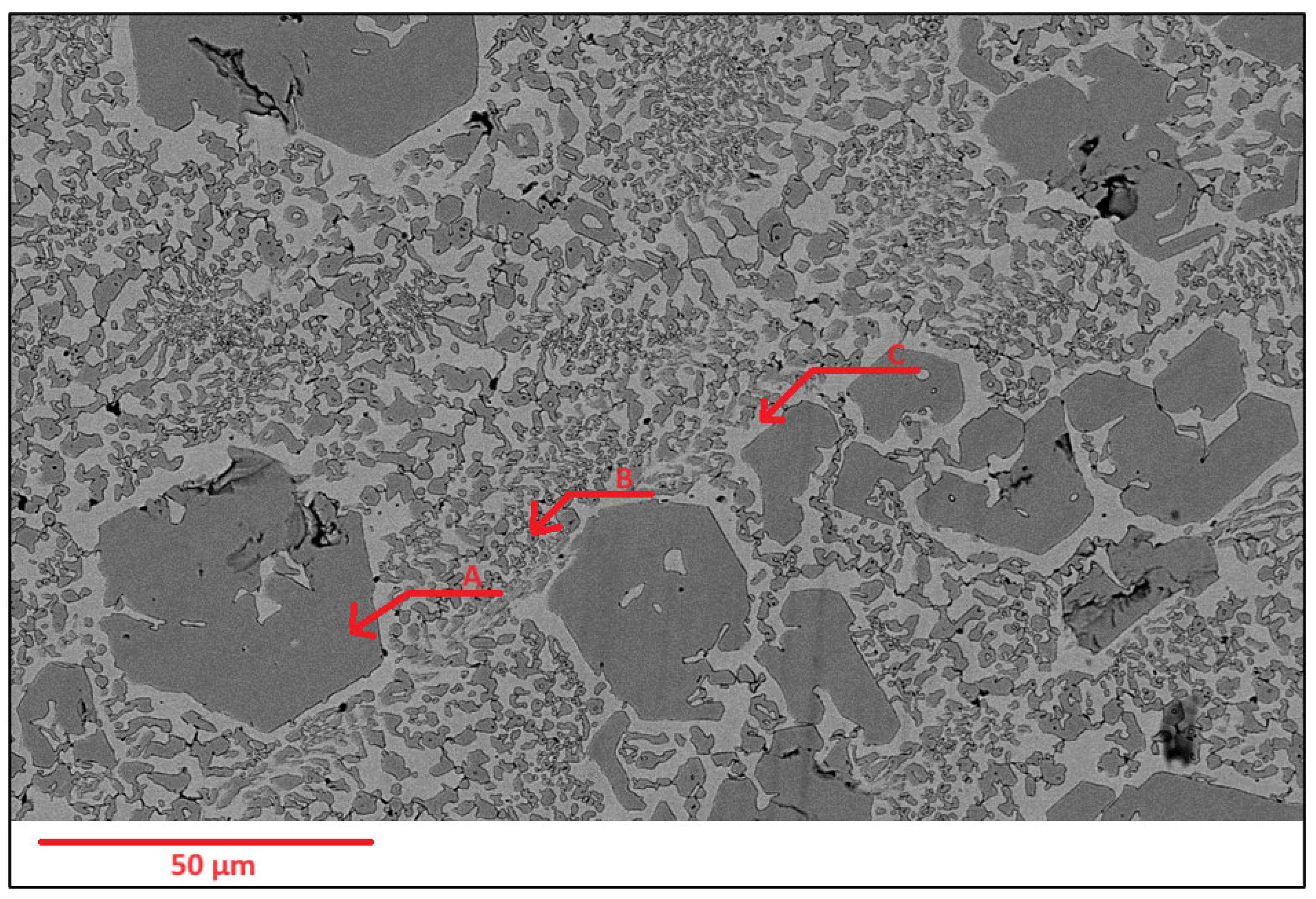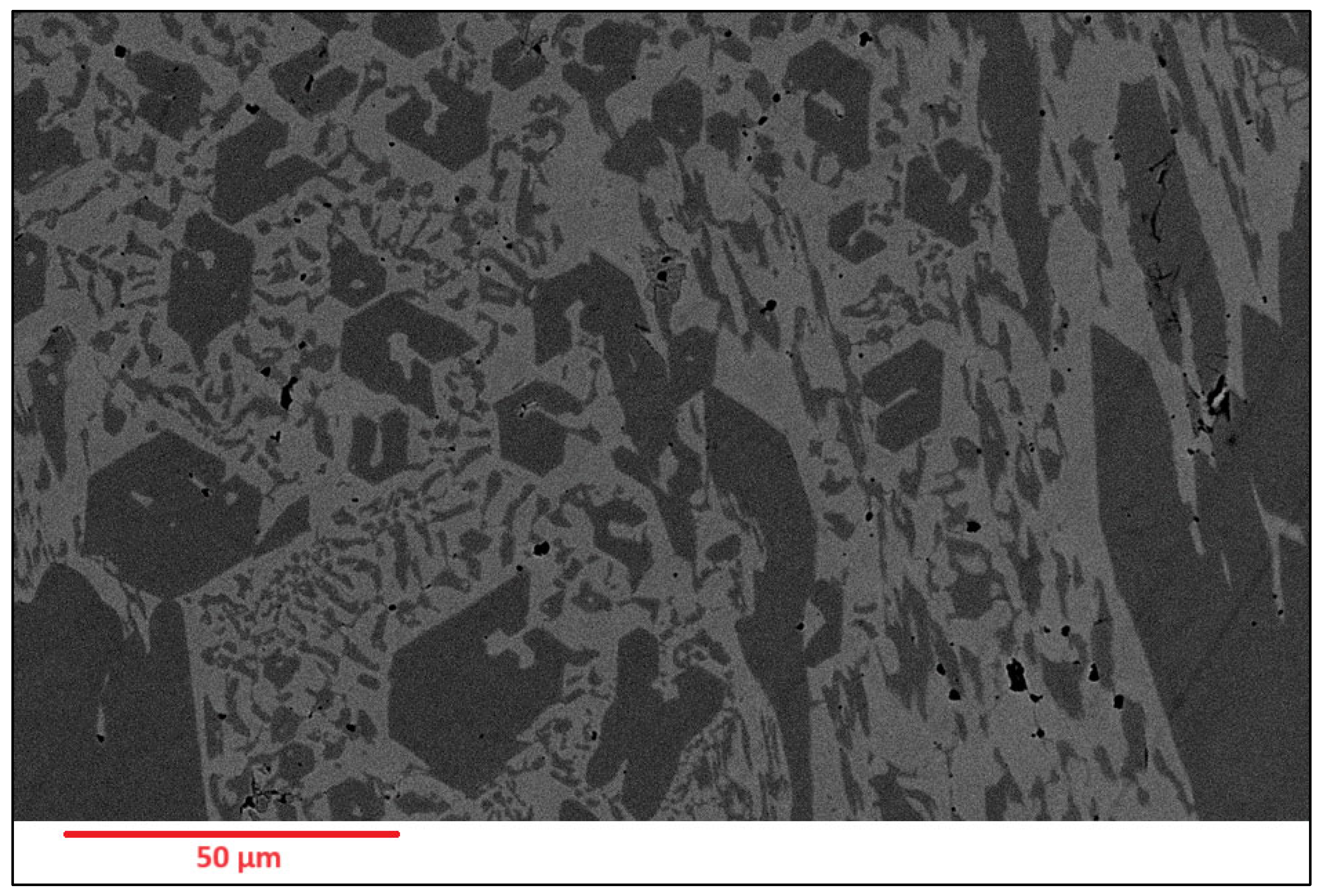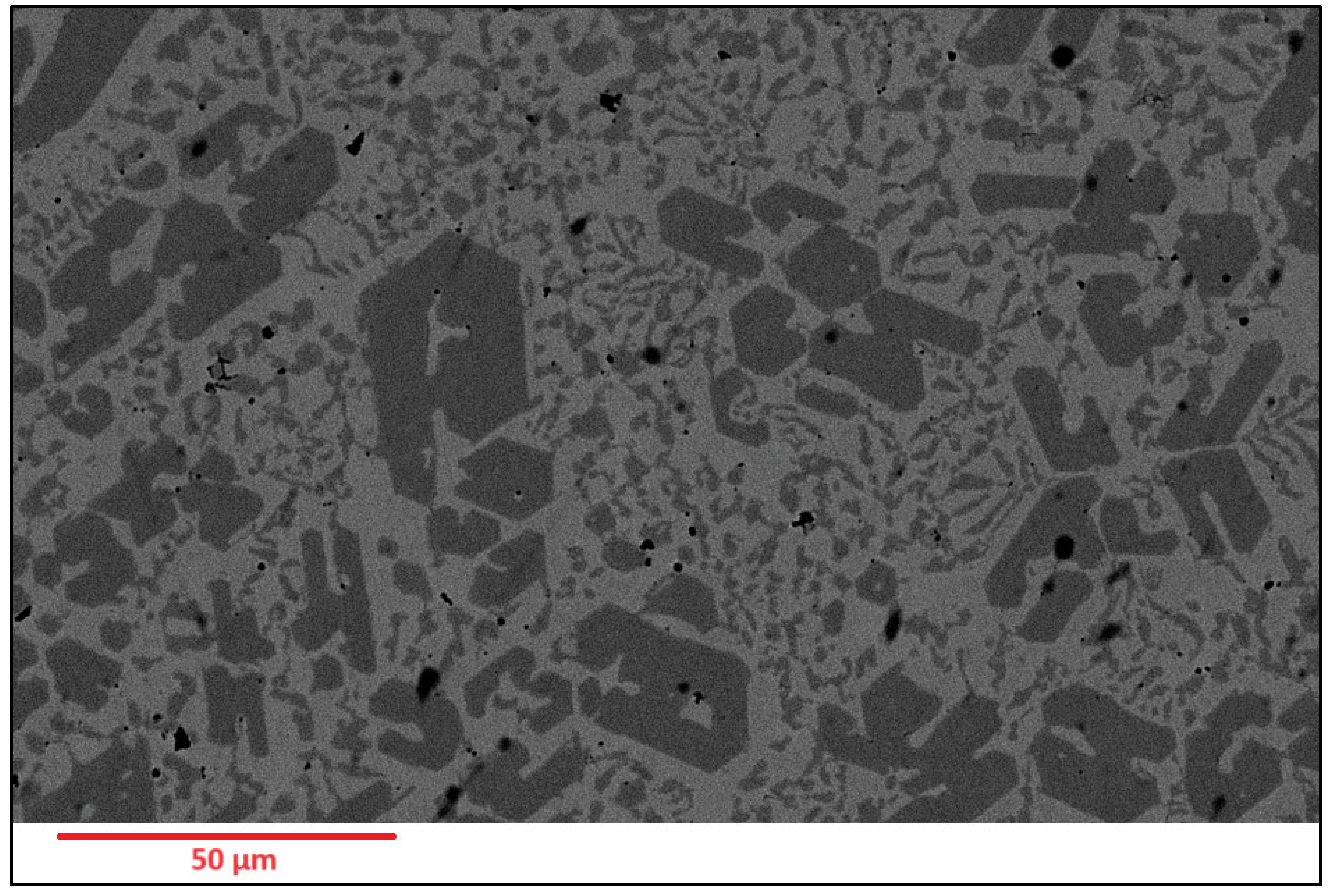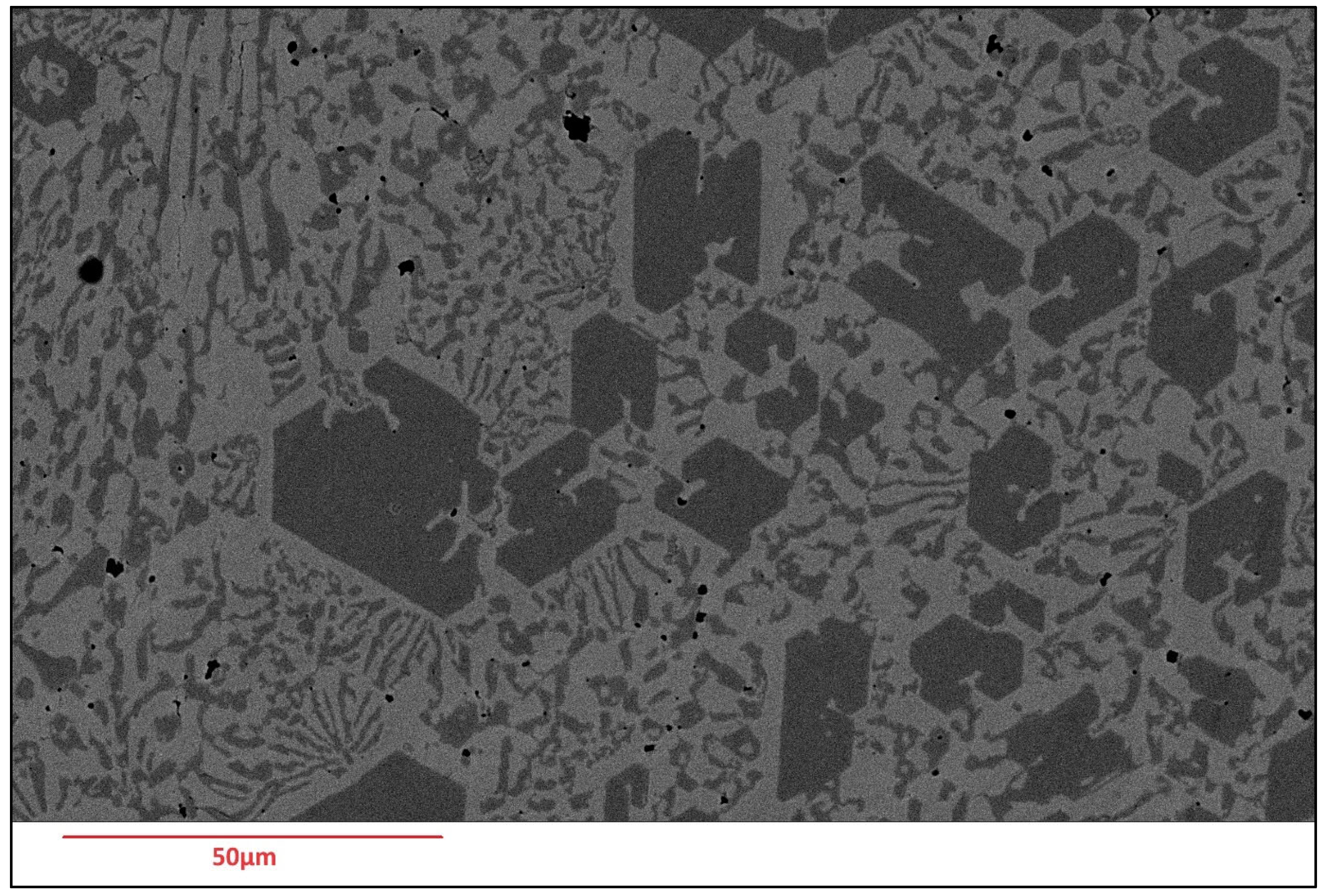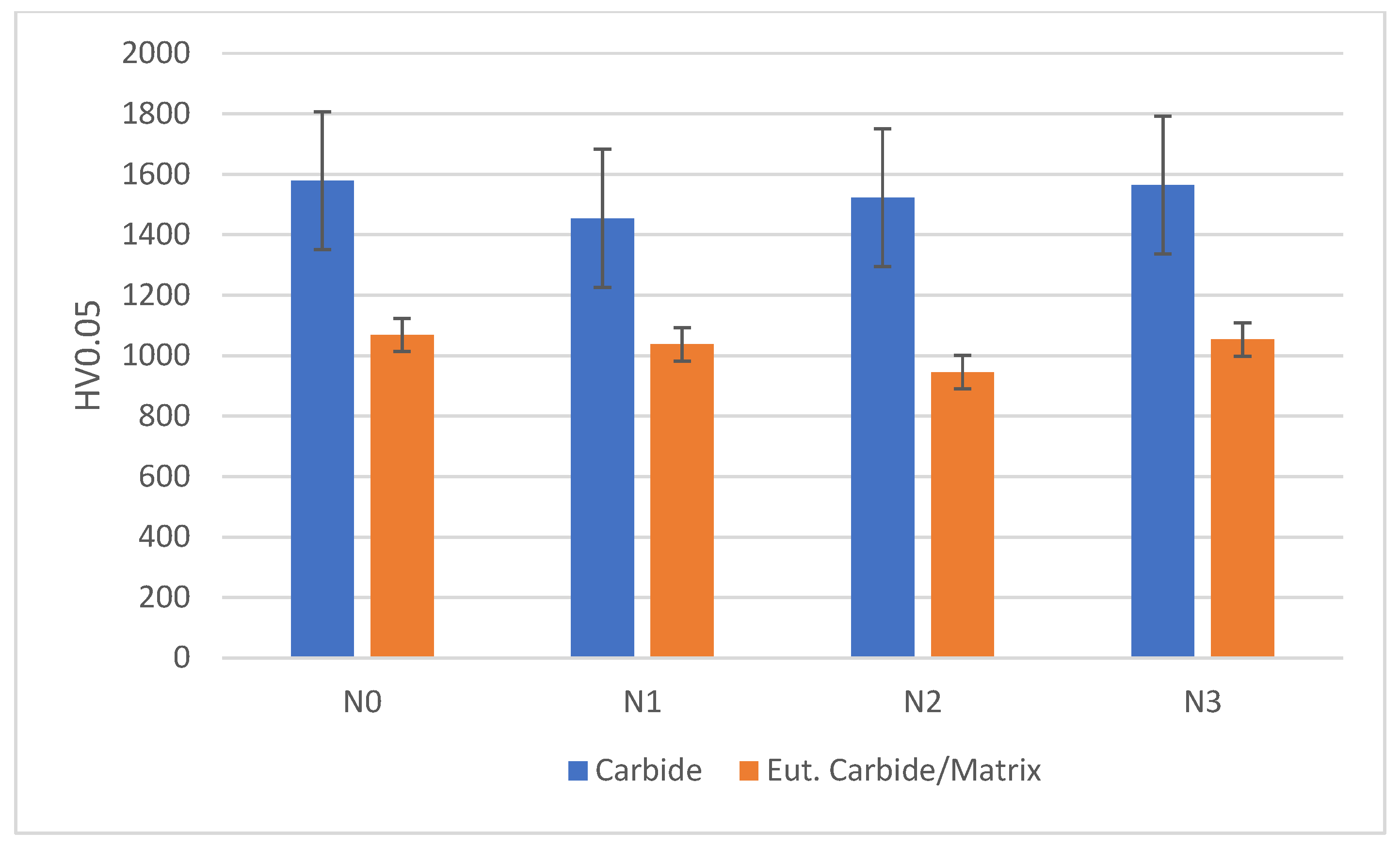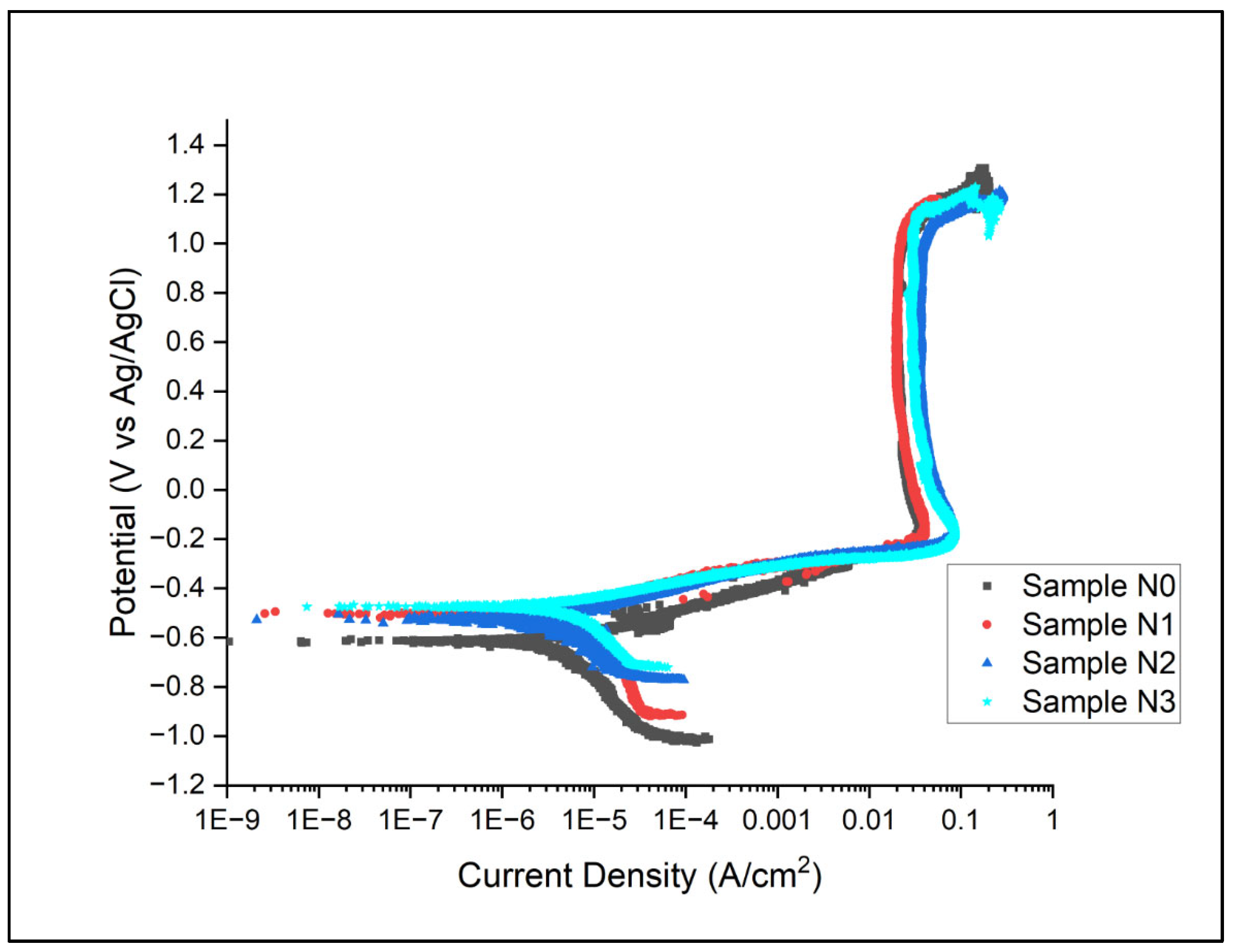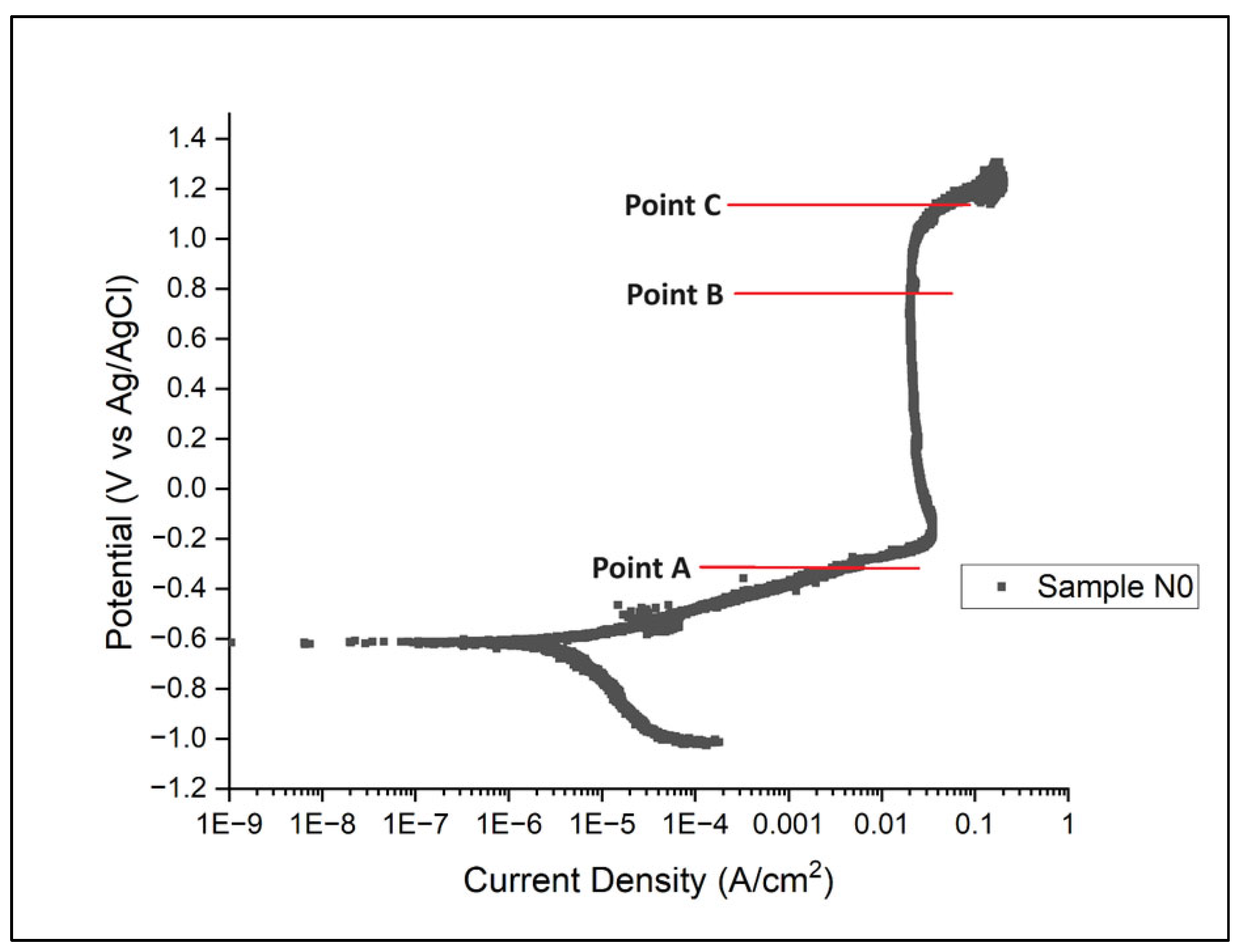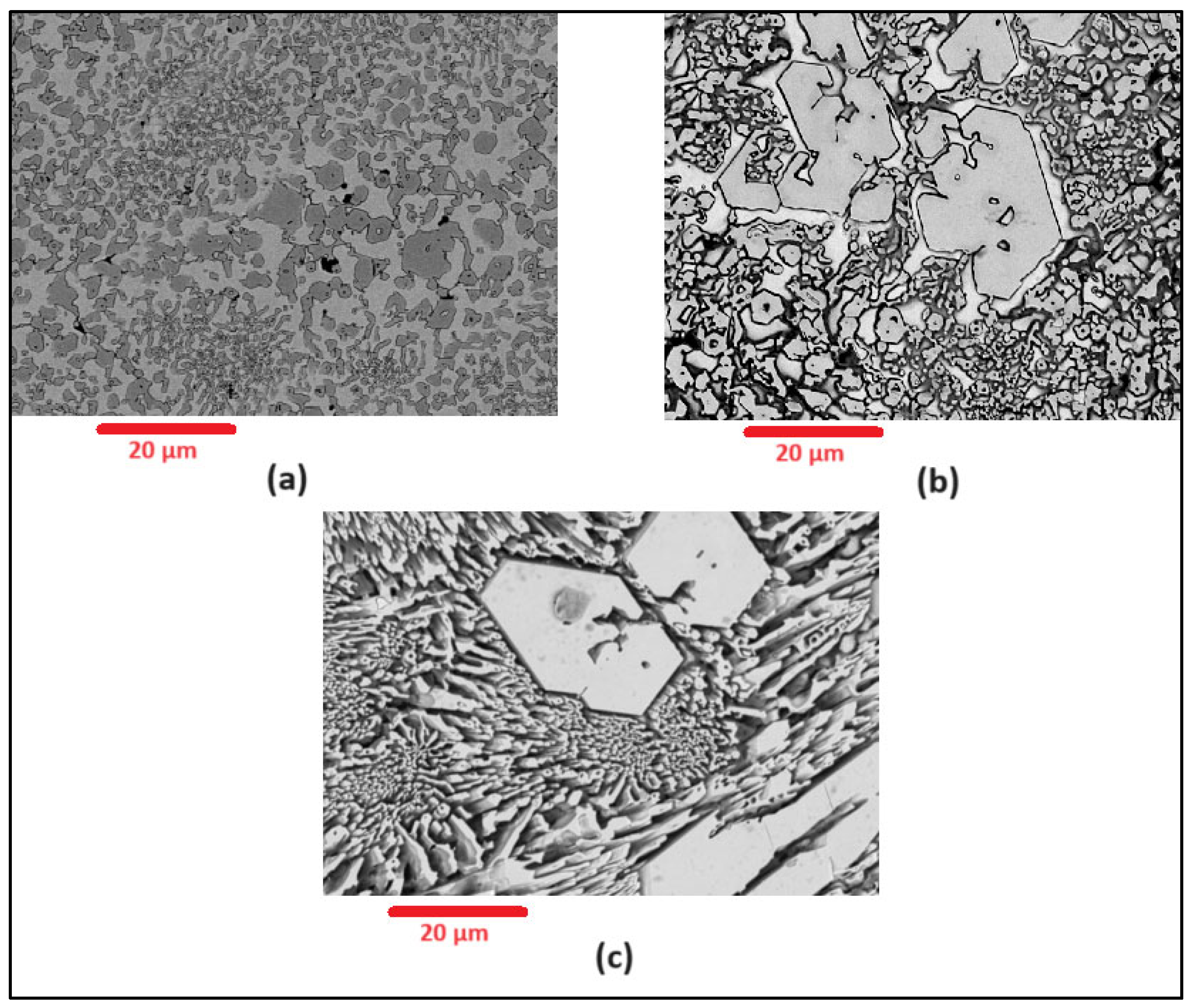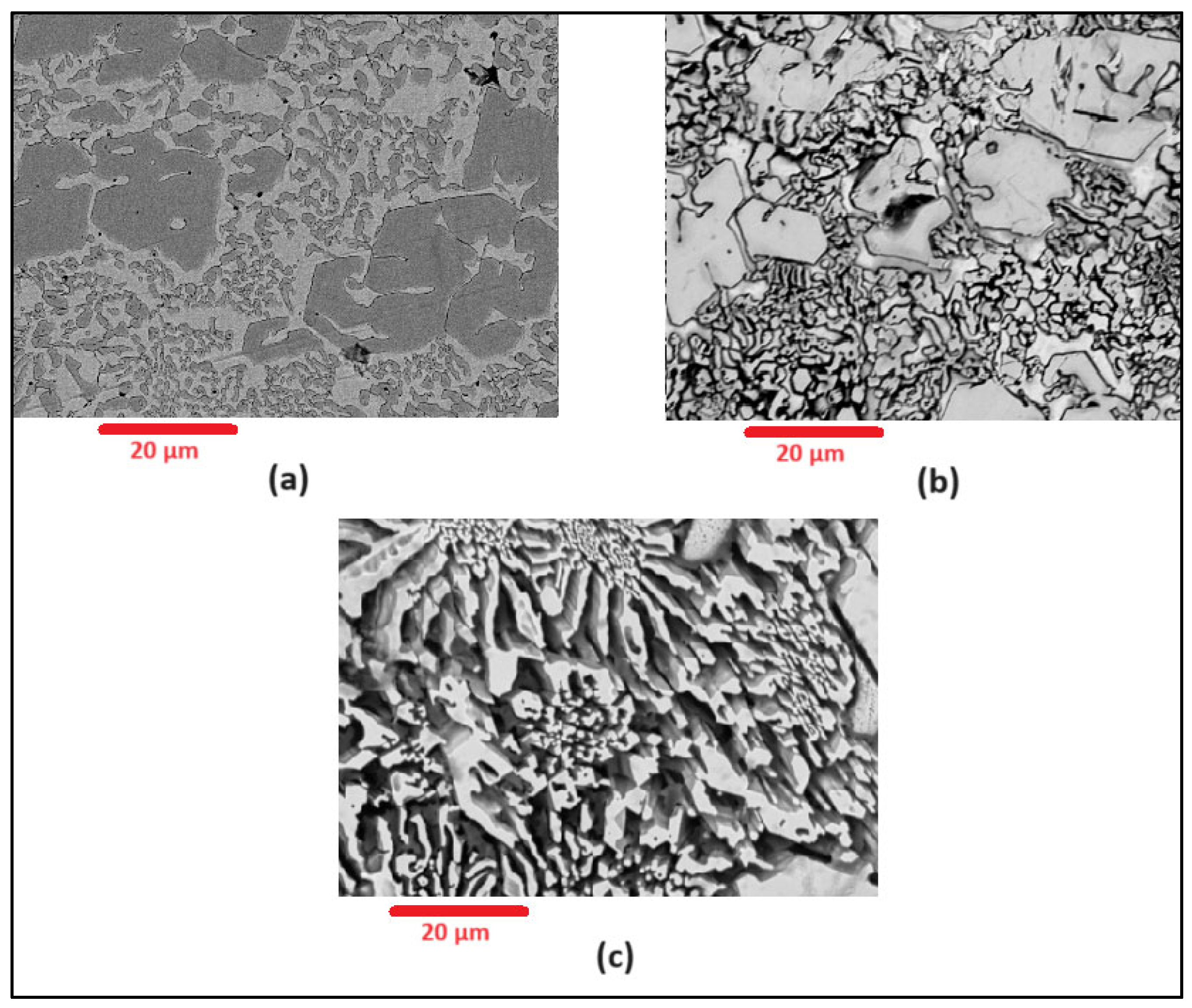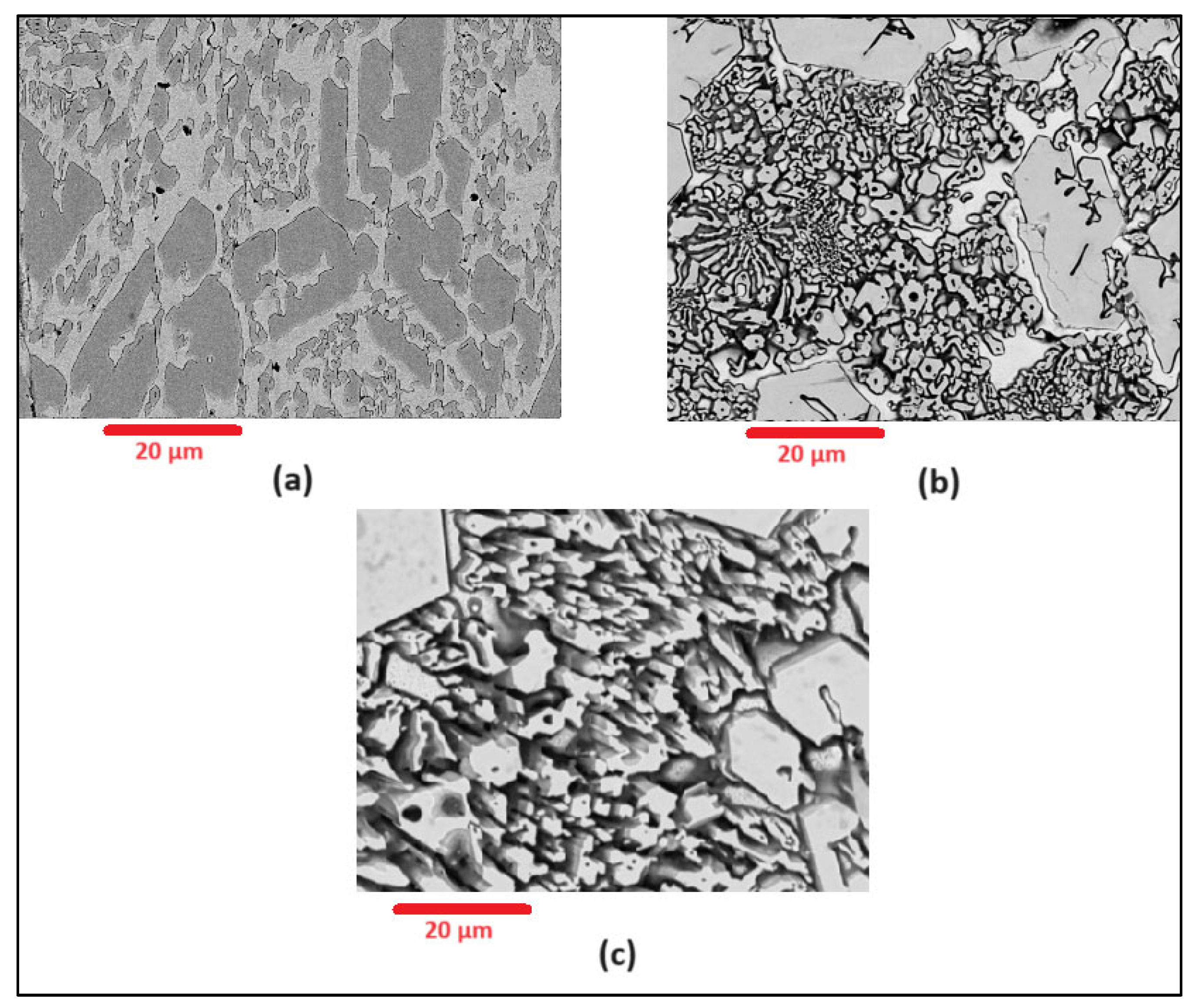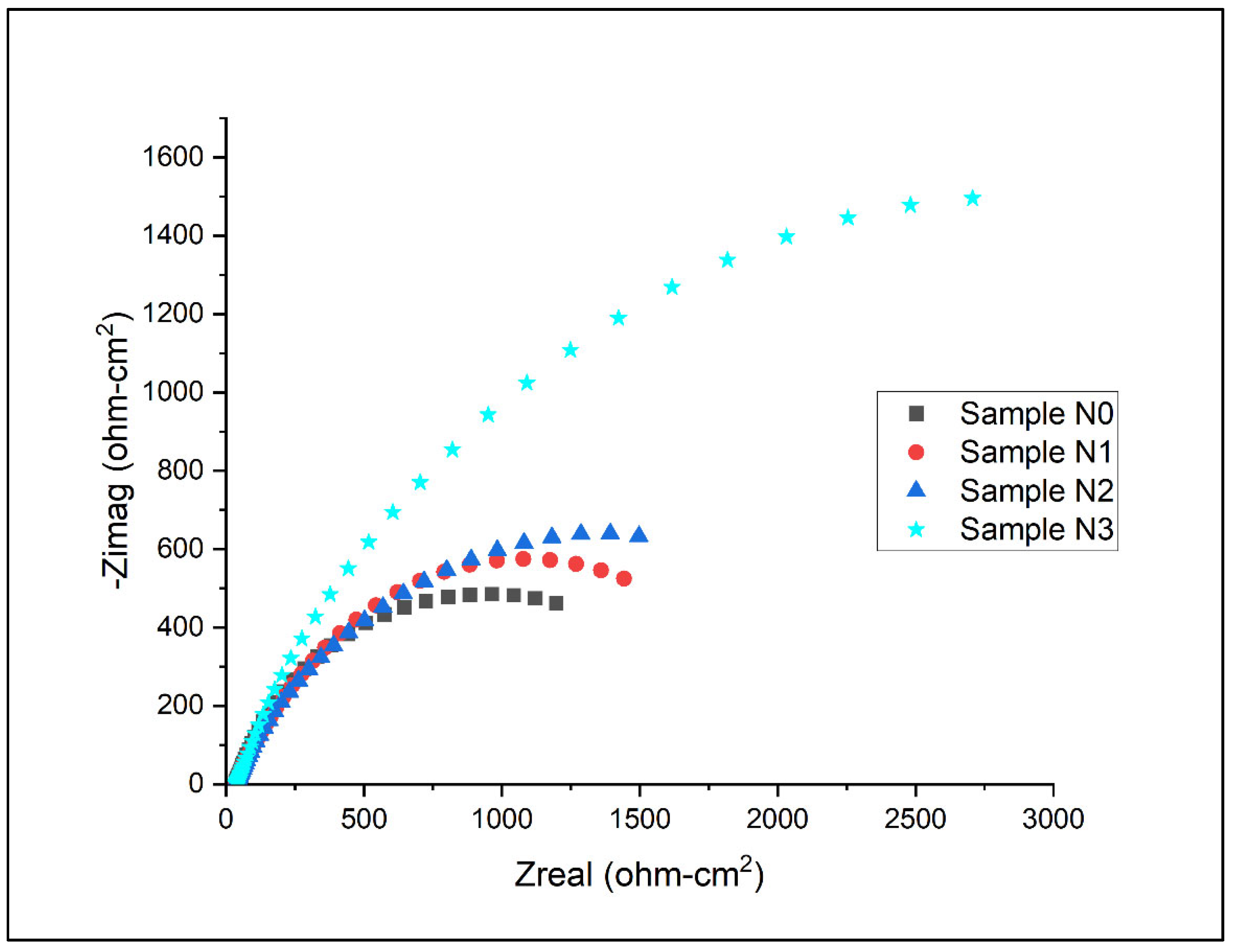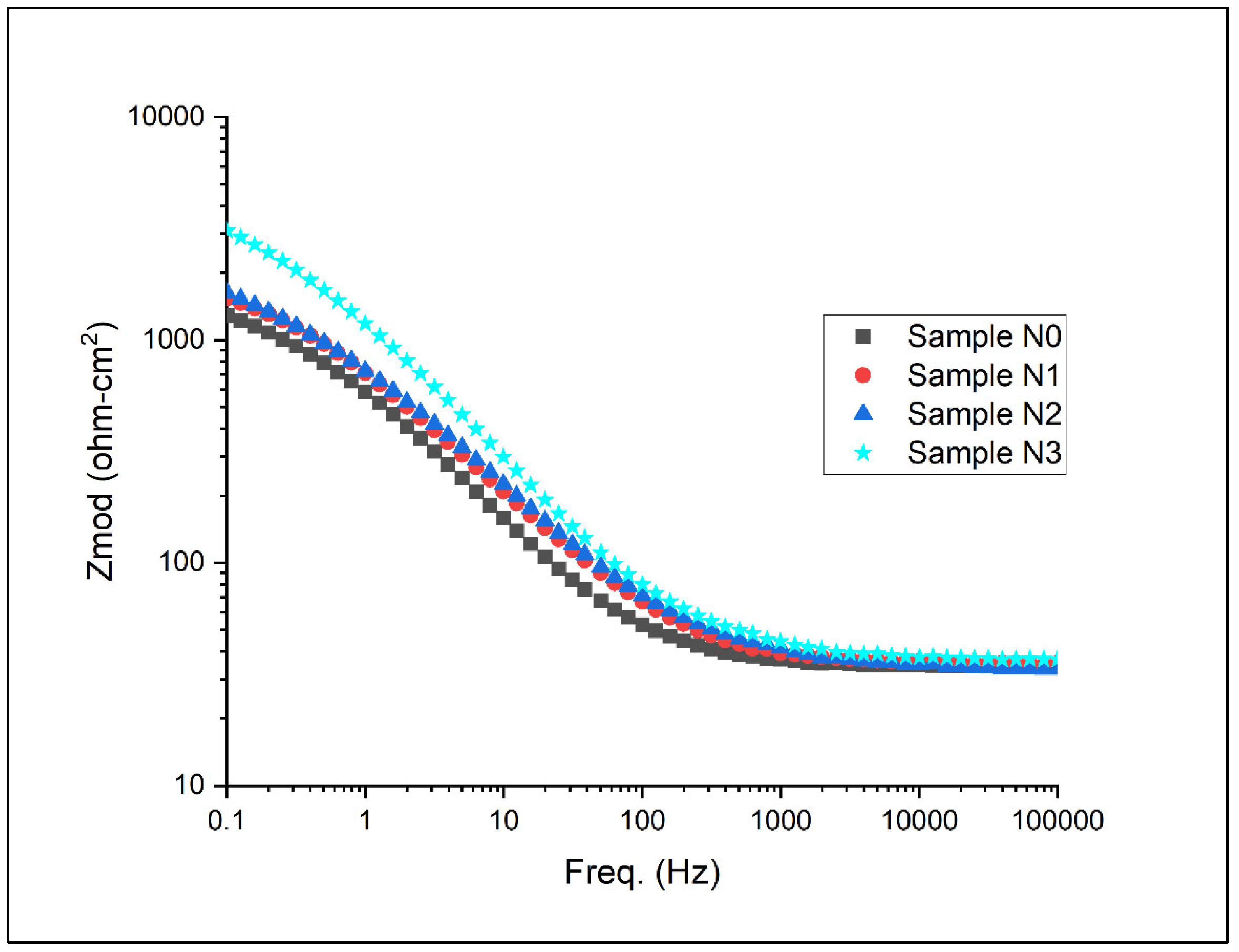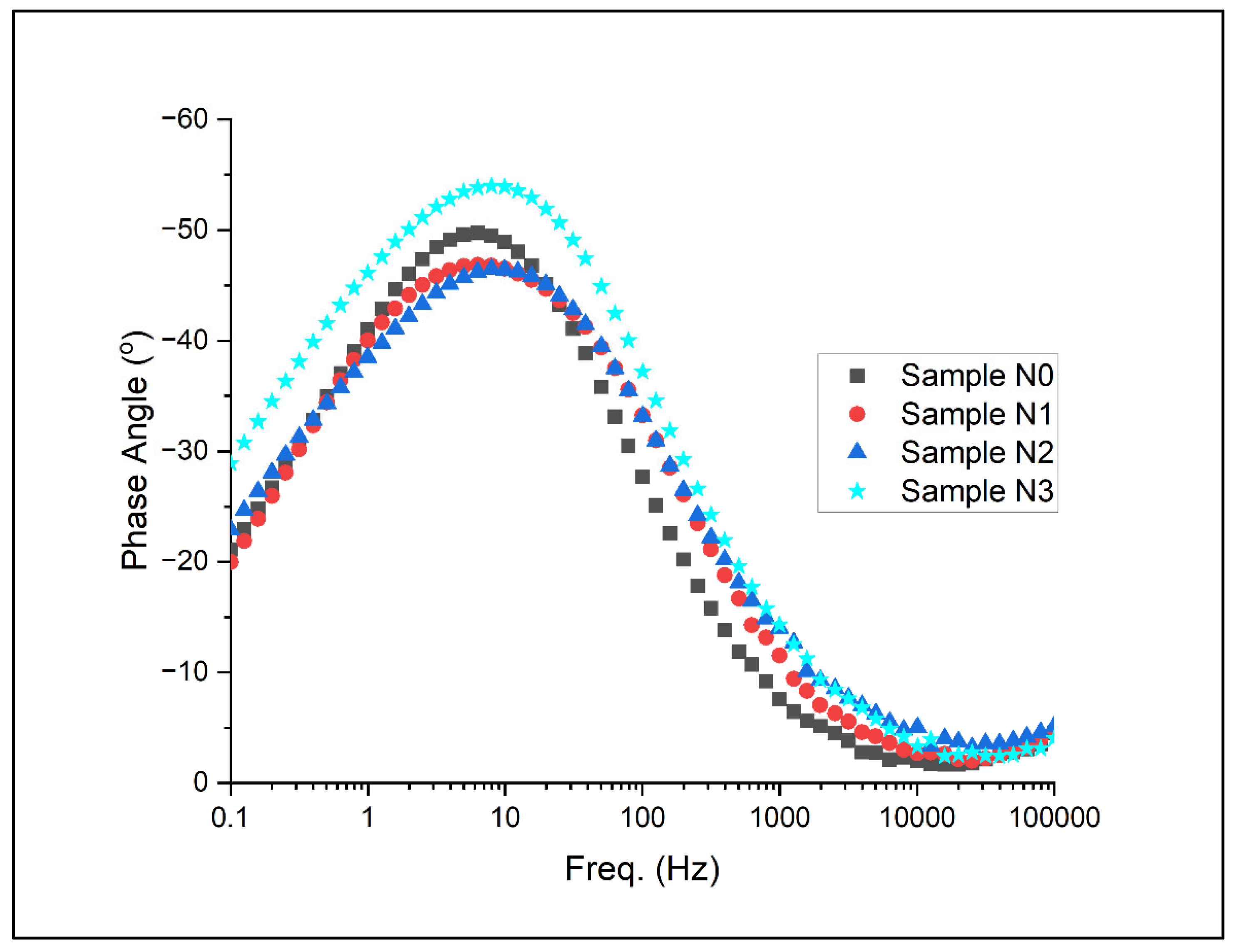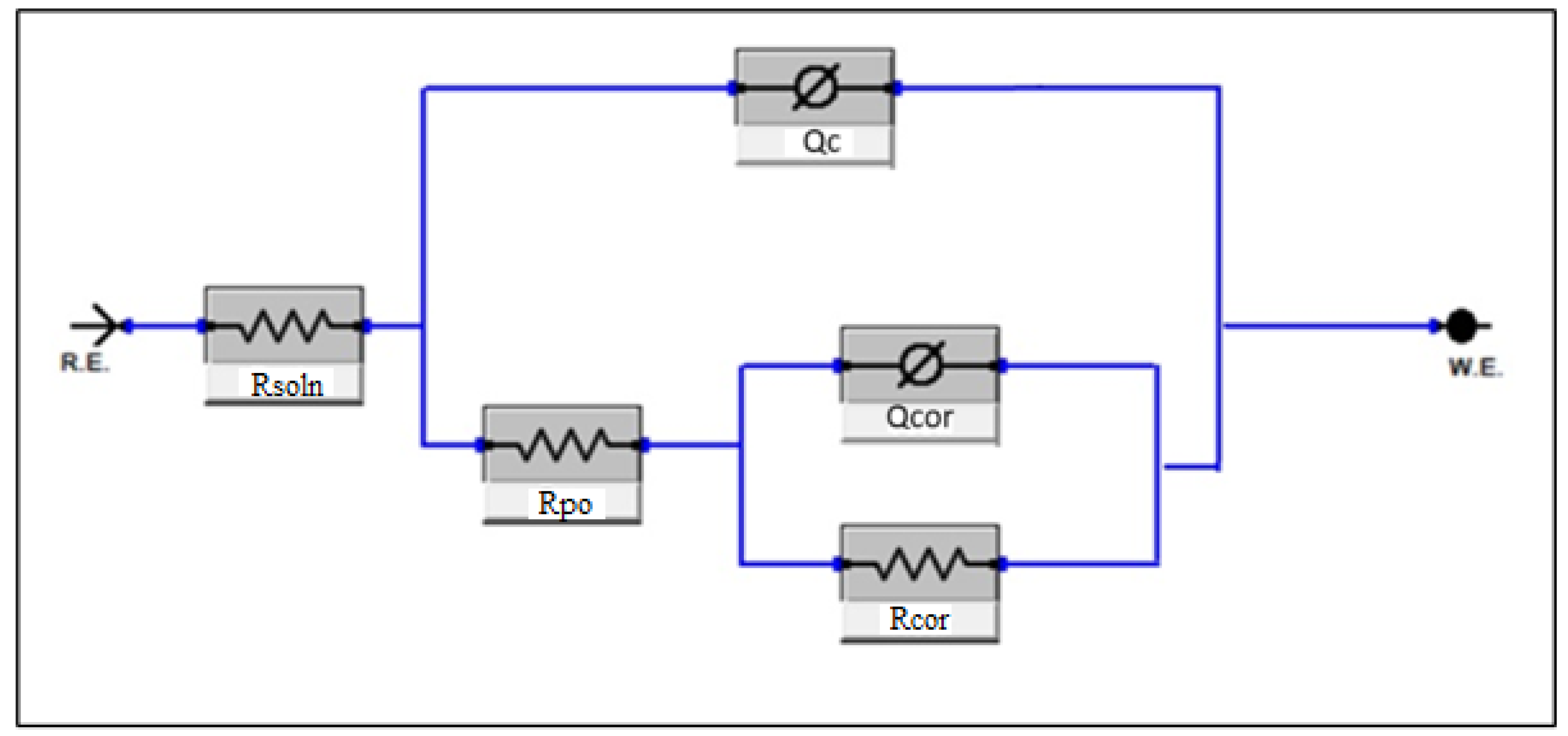3.4. Potentiodynamic and Potentiostatic Results
Potentiodynamic results for the samples in artificial seawater conditions are as shown in
Figure 7.
From the results in
Figure 7, the E
corr and I
corr values for all samples are as shown in
Table 9. This was evaluated through the Gamry EChem Analyst software (ver 7.9.0) using Tafel methodology.
The potentiodynamic polarisation curves presented in
Figure 7, coupled with the corrosion parameters summarised in
Table 10, provide valuable insights into the electrochemical behaviour of the hardfacing deposits (N0, N1, N2, and N3) in artificial seawater. These results illuminate the effects of nitrogen shielding gas on the corrosion resistance of the alloys. The corrosion potential (E
corr) shows a significant positive shift with the introduction of nitrogen during the welding process, from −618 mV for Alloy N0 to −474 mV for Alloy N3, indicating that the nitrogen-containing alloys are thermodynamically more stable in a corrosive environment. However, the corrosion current density (I
corr) values do not follow a clear trend with increasing levels of nitrogen content, suggesting that while nitrogen improves the thermodynamic stability, the kinetics of corrosion are influenced by other factors, possibly microstructural changes induced by the nitrogen shielding. Examination of the passive regions reveals that nitrogen-shielded alloys generally show earlier passivation, lower passive current densities, wider passive ranges, and higher breakdown potentials, all indicating more stable and protective passive films. The cathodic portions of the curves also show differences, with nitrogen-shielded alloys generally exhibiting lower cathodic current densities and steeper slopes, suggesting changes in the kinetics of the cathodic reaction. Overall, the nitrogen-shielded alloys demonstrate improved corrosion resistance compared to Alloy N0, with Alloy N3 (15 L/min N2) offering the best overall performance. These improvements can be attributed to several factors, including microstructural modifications, increased nitrogen content in the austenite, possible formation of nitrogen-enriched surface layers, and alterations in the electrochemical properties of the alloy surface.
Potentiostatic etching was carried out at Points A, B, and C, as shown in
Figure 8; these values are provided in
Table 10.
From these points, SEM images of potentiostatically etched alloys are shown in
Figure 9,
Figure 10,
Figure 11 and
Figure 12. EDS was carried out for the primary carbides and austenite to evaluate the potential changes in composition post etching. These compositional results are shown in
Table 11 and
Table 12. Notably, the composition of the carbides did not appear to significantly change throughout potentiostatic etching, with detected elements all lying within ~3% of each other. However, oxygen appears to significantly increase within the austenite for all alloys when etched at 800 mV to ~35 wt%, whereas this was previously undetected when etched at −330 mV. This suggests the growth of products such as oxides.
Building upon the potentiodynamic analysis, further insights can be gleaned by correlating these results with the potentiostatic etching data presented in
Table 10,
Table 11 and
Table 12, and visualised in
Figure 9,
Figure 10,
Figure 11 and
Figure 12. The potentiostatic points chosen at −330 mV, 800 mV, and 1100 mV (
Table 11) correspond to distinct regions in the polarisation curves, allowing for a more detailed examination of the corrosion mechanisms. At −330 mV, near the corrosion potential, minimal changes were observed in the microstructure across all alloys. However, at 800 mV, within the passive region, significant differences emerged. The EDS results in
Table 12 reveal a substantial increase in oxygen content within the austenite for all alloys, ranging from 33.1 wt% to 39.9 wt%, indicating the formation of oxide layers. Notably, the nitrogen-containing alloys (N1, N2, and N3) showed a more pronounced decrease in chromium content in the austenite compared to N0, suggesting a more efficient incorporation of chromium into the passive film. This corroborates the improved passive behaviour observed in the polarisation curves. At 1100 mV, in the transpassive region, the austenite was almost completely dissolved for all alloys, as evidenced by
Figure 9,
Figure 10,
Figure 11 and
Figure 12. Interestingly, the carbide composition remained stable throughout the potentiostatic etching, as shown in
Table 11, with only slight increases in oxygen content (1.2–3.0 wt%) at 1100 mV. This stability of the carbides, coupled with the preferential dissolution of the austenite, supports the hypothesis of galvanic corrosion between the austenite and the carbides. Alloy N3 aligns with the superior corrosion resistance indicated by the polarisation curves. These observations collectively suggest that the addition of nitrogen not only enhances the stability of the passive film, but also modifies the microstructure in a way that mitigates the galvanic effect between the austenite and carbides, thereby improving overall corrosion resistance.
3.5. Electrochemical Impedance Spectroscopy Results
Electrochemical impedance spectroscopy (EIS) results for the samples under artificial seawater conditions are as shown for the Nyquist plots and Bode plots in
Figure 13,
Figure 14 and
Figure 15 below.
Using the data from the EIS results, equivalent circuit models can be fit in to gauge how the system corrodes based off of its modelled resistances and capacitances [
20]. For hardfaced coatings such as HCWI, these are typically expected to be modelled by the double-layer model of the form Rsoln[Cc[Rpo[CcorRcor]]]. In this model, Rsoln represents the solution resistance, CC represents the overall coating capacitance, Rpo represents the porous resistance of the coating, Ccor represents the double-layer capacitance, and Rcor represents the charge transfer resistance. It should be noted that this model has been found to fit more reliably when modelling the capacitors (C) as constant phase elements (Q) due to not acting perfectly as capacitors; as such, it may be better described by the model Rsoln[Qc[Rpo[QcorRcor]]], as seen in
Figure 16. This may stem from non-homogenous elements within the system such as porosities or imperfections.
Using this model, the following EIS parameters in
Table 13 were found for Alloys N0 to N3.
Chi-squared values for all samples were all below 1 × 10−3, indicating a high level of fit for all equivalent circuit models.
The electrochemical impedance spectroscopy (EIS) results, as depicted in
Figure 13 and quantified in
Table 13, provide further insight into the corrosion behaviour of the high-chromium hardfacing alloys with varying levels of nitrogen content. The Nyquist plots in
Figure 13 reveal distinct semicircular arcs for all alloys, characteristic of a charge-transfer-controlled corrosion process. The diameter of these semicircles is directly related to the charge transfer resistance, which is indicative of the corrosion resistance of the alloys.
A clear trend is observed in the size of the semicircles, with Alloy N3 exhibiting the largest arc, followed by N2, N1, and N0. This progression aligns well with the corrosion resistance parameters (Rcor) derived from the equivalent circuit modelling in
Table 13. The Rcor values increase from 2325 Ω·cm
2 for Alloy N0 to 4700 Ω·cm
2 for Alloy N3, quantitatively confirming the enhanced corrosion resistance with increasing nitrogen content. This trend corroborates the findings from the potentiodynamic polarisation tests, reinforcing the beneficial effect of nitrogen on the alloys’ corrosion behaviour.
The equivalent circuit parameters in
Table 13 offer additional insights into the electrochemical processes at the alloy–electrolyte interface. The coating capacitance (Qc) and its associated exponential term (n) provide information about the homogeneity and protectiveness of the surface film. The lower Qc values for nitrogen-containing alloys, particularly N3 (0.000195 Ω
−1cm
−2sn), suggest the formation of a more compact and protective surface layer.
The porous resistance of the coating (Rpo) shows a significant increase with increased nitrogen content, from 19.93 Ω·cm2 for N0 to 3795 Ω·cm2 for N3. This substantial rise indicates that the nitrogen-induced microstructural changes lead to a more resistant outer layer, potentially due to the formation of a more stable passive film or alterations in the carbide–austenite interface.
The double-layer capacitance (Qcor) and its exponential term (n) provide insights into the characteristics of the electrical double layer at the alloy–electrolyte interface. The decreasing Qcor values from N0 (0.000289 Ω−1cm−2sn) to N3 (0.000117 Ω−1cm−2sn) suggest a more compact and less-defective interface layer in the nitrogen-rich alloys. This trend aligns with the improved passive film stability observed in the potentiodynamic tests and the microstructural changes evidenced by the potentiostatic etching results.
The increasing n values associated with Qcor, from 0.7413 for N0 to 0.8657 for N3, indicate a surface that behaves more like an ideal capacitor with increasing levels of nitrogen content. This could be interpreted as a more uniform and homogeneous surface layer, possibly due to the more even distribution of alloying elements or a more consistent passive film formation.
These EIS results, when considered alongside the potentiodynamic and potentiostatic findings, paint a comprehensive picture of the corrosion mechanism in these alloys. The nitrogen addition appears to enhance corrosion resistance through multiple mechanisms, given as follows: (a) the formation of a more stable and protective passive film, as evidenced by the increased Rcor and Rpo values; (b) the development of a more homogeneous surface layer, indicated by the changes in Qc, Qcor, and their associated n values; (c) possible modification of the carbide–austenite interface, leading to reduced galvanic coupling effects, as suggested by the potentiostatic etching results and the enhanced overall impedance.
The Bode plots presented in
Figure 14 and
Figure 15 offer complementary insights into the Nyquist plots and further elucidate the electrochemical behaviour of the high-chromium white iron alloys.
Figure 14 displays the magnitude of impedance |Z| as a function of frequency. At high frequencies (>103 Hz), all alloys exhibit similar low impedance values, primarily representing the solution resistance. As the frequency decreases, the impedance increases, with clear differences emerging among the alloys. In the mid-frequency range (1 to 103 Hz), the slopes of the curves provide information about the capacitive behaviour of the electrode–electrolyte interface. Notably, Alloy N3 shows the steepest slope, followed by N2, N1, and N0, indicating an increasing capacitive character with higher nitrogen content. This aligns with earlier observations of improved passive film formation in nitrogen-rich alloys.
At low frequencies (<1 Hz), where the impedance is dominated by the charge transfer resistance and diffusion processes, a clear hierarchy in impedance values is indicated. Alloy N3 consistently displays the highest impedance, followed by N2, N1, and N0. This trend corroborates the Rcor values obtained from the equivalent circuit modelling and further confirms the enhanced corrosion resistance with increasing nitrogen content. The higher low-frequency impedance suggests a more effective barrier against charge transfer and mass transport processes at the alloy surface.
Figure 15 presents the phase angle as a function of frequency, offering insights into the nature of the electrochemical processes occurring at different timescales. In the high-frequency region, all alloys show a phase angle near 0°, characteristic of resistive behaviour dominated by the electrolyte resistance. As the frequency decreases, a shift occurs towards more negative phase angles, indicating an increasing contribution of capacitive elements.
The mid-frequency region (100 to 103 Hz) reveals distinct differences among the alloys. Alloy N3 exhibits the widest frequency range, with phase angles approaching −70° to −80°, suggesting a more ideal capacitive behaviour. This broad capacitive region indicates a more stable and protective surface film, consistent with observations from the potentiodynamic and potentiostatic tests. The phase angle peaks for N2 and N1 are slightly less pronounced and span a narrower frequency range, while N0 shows the least-pronounced capacitive behaviour.
In the low-frequency region (<100 Hz), a trend towards less-negative phase angles is observed, indicating an increasing influence of resistive components. This transition is most gradual for Alloy N3, maintaining higher phase angles down to lower frequencies compared to the other alloys. This behaviour suggests that N3 maintains its capacitive character over a wider frequency range, implying a more effective barrier against corrosive species even at longer time scales.
The presence of a single, broad time constant in the Bode plots for all alloys supports the choice of the equivalent circuit model. However, the subtle differences in the shapes of the phase angle curves, particularly in the low-frequency region, hint at the complexity of the electrochemical processes occurring at the alloy–electrolyte interface. These nuances may be attributed to the varying distributions of carbides, the nature of the passive film, and potential diffusion processes within the surface layers.
